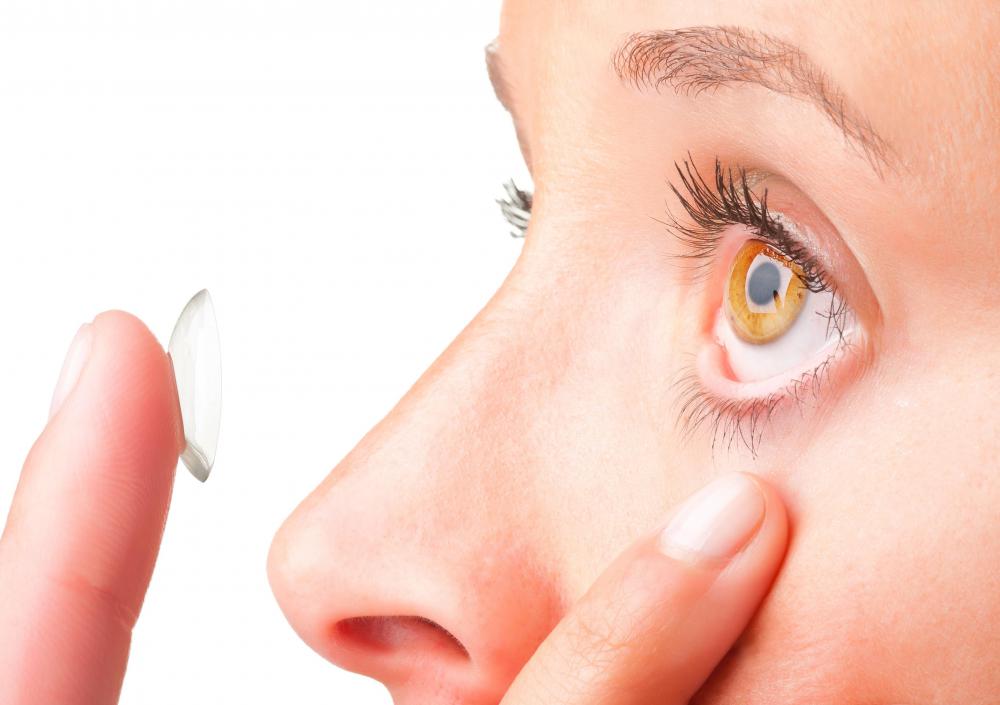At TheHealthBoard, we're committed to delivering accurate, trustworthy information. Our expert-authored content is rigorously fact-checked and sourced from credible authorities. Discover how we uphold the highest standards in providing you with reliable knowledge.
What is the Cornea?
The cornea is the transparent portion of the eye which allows light to enter and performs two-thirds of the focusing tasks. This part also covers both the iris, the colored portion of the external eye, and the pupil, the reactive "light meter" in front of the lens. There are no blood vessels in the cornea, but there are several nerves. Nutrients for this portion are supplied by the same source as the tear ducts and internal vitreous fluids.
This part of the eye is often compared to the lens of a camera, but this can lead to a bit of confusion. The cornea does indeed allow light to enter the eyeball, and its convex shape focuses that light towards the pupil and another structure called the lens. In essence, the cornea performs the broad brushstrokes of vision, while the shape-shifting lens performs the fine details before all of the light hits the retina. It is the shape of its dome that determines whether or not a person may be nearsighted, farsighted or astigmatic.

During vision correction procedures, external lenses may be used to refocus images in the eye's lens or the shape of the cornea may be modified. Contact lenses placed directly on the cornea change its thickness, creating a new focal point. Some advanced contact lenses use tension to reshape the entire cornea, allowing near-normal vision until it resumes its original shape and the blurriness returns.

Advanced surgical procedures such as Lasik make tiny incisions on the cornea which should create a new degree of curvature as they heal. Topical anesthetics numb the nerves leading to the area, and the procedure is virtually bloodless. Occasionally, the cornea may become scratched by external objects or a stray eyelash under the eyelid. Removing the debris may be a simple matter of applying an approved eyewash or eye drops, but it often takes a few days for the eye to heal from scratches.

Some people may develop serious medical conditions involving the cornea, including corneal cancer and ulcerations. Because it does not contain blood, the tissue is remarkably resistant to rejection. This has led to the development of corneal transplant surgeries. Many organ donors list the cornea as one of their harvestable tissues after death. Unlike other organs and tissues, healthy tissue is almost always compatible with patients waiting to receive it.
AS FEATURED ON:
AS FEATURED ON:














Discussion Comments
There is type of surgery that has apparently gained popularity in some countries, at least, promising to actually change your eye color with some sort of "implants". The general consensus on this, however, is nearly everyone who gets it either suffers from partial blindness, is in horrible pain, or at the very least does not get the effect they want. Seriously, if you are considering some sort of cosmetic surgery, ask yourself, "Is this really worth it?" I doubt new eye color would make most of us, if we are unhappy about how we look, any happier.
There is some risk in Lasik surgery. While it nearly always works wonders, some people will find their cornea either damaged beyond repair or, at the very least, that one eye is fixed and the other has even worse vision than before. To avoid this, it is recommended you find a doctor who is both very experienced in eye surgery and extremely trusted in the community. "Cheap" eye surgery, particularly cornea surgery is not a good idea, pretty much ever.
Post your comments